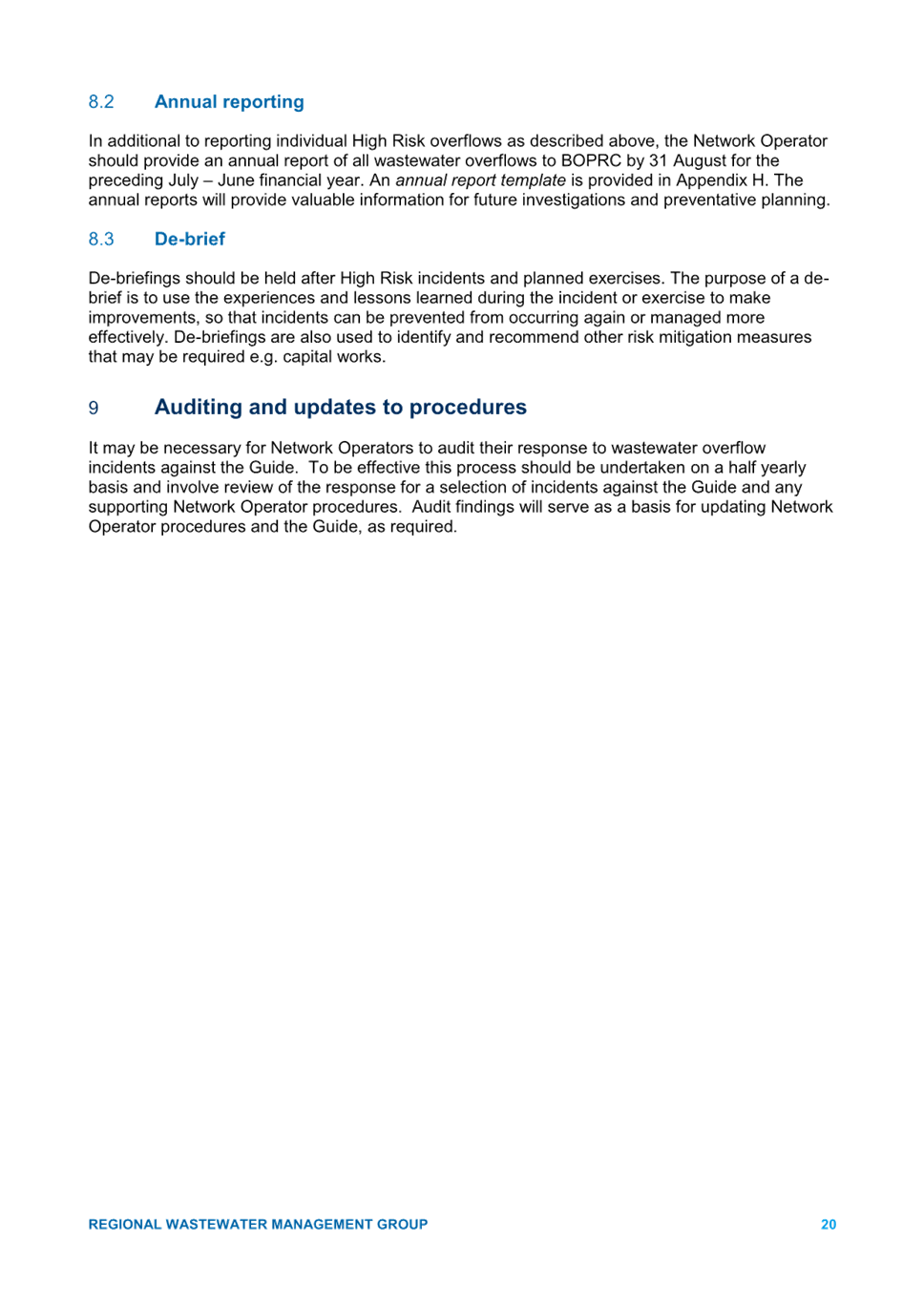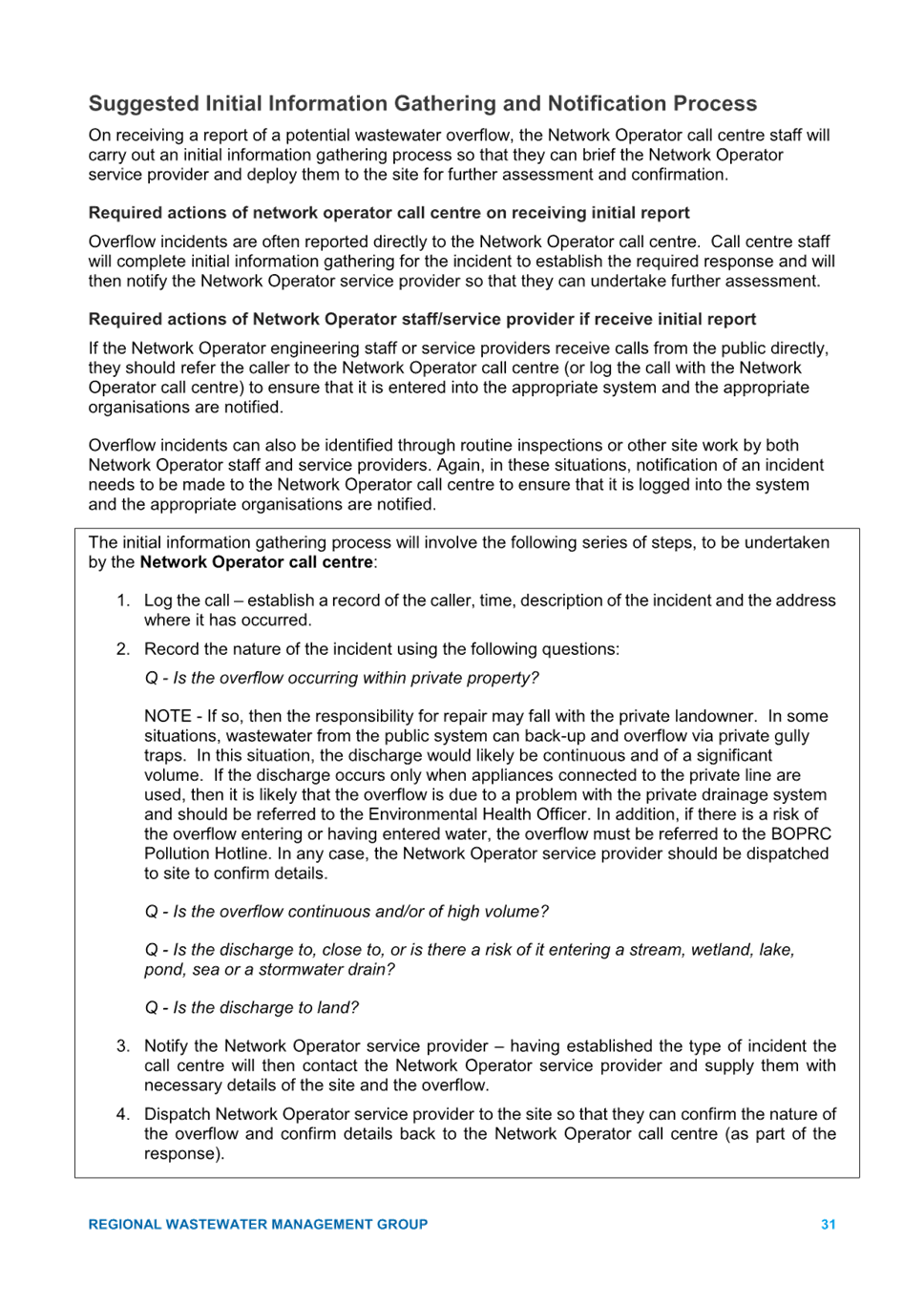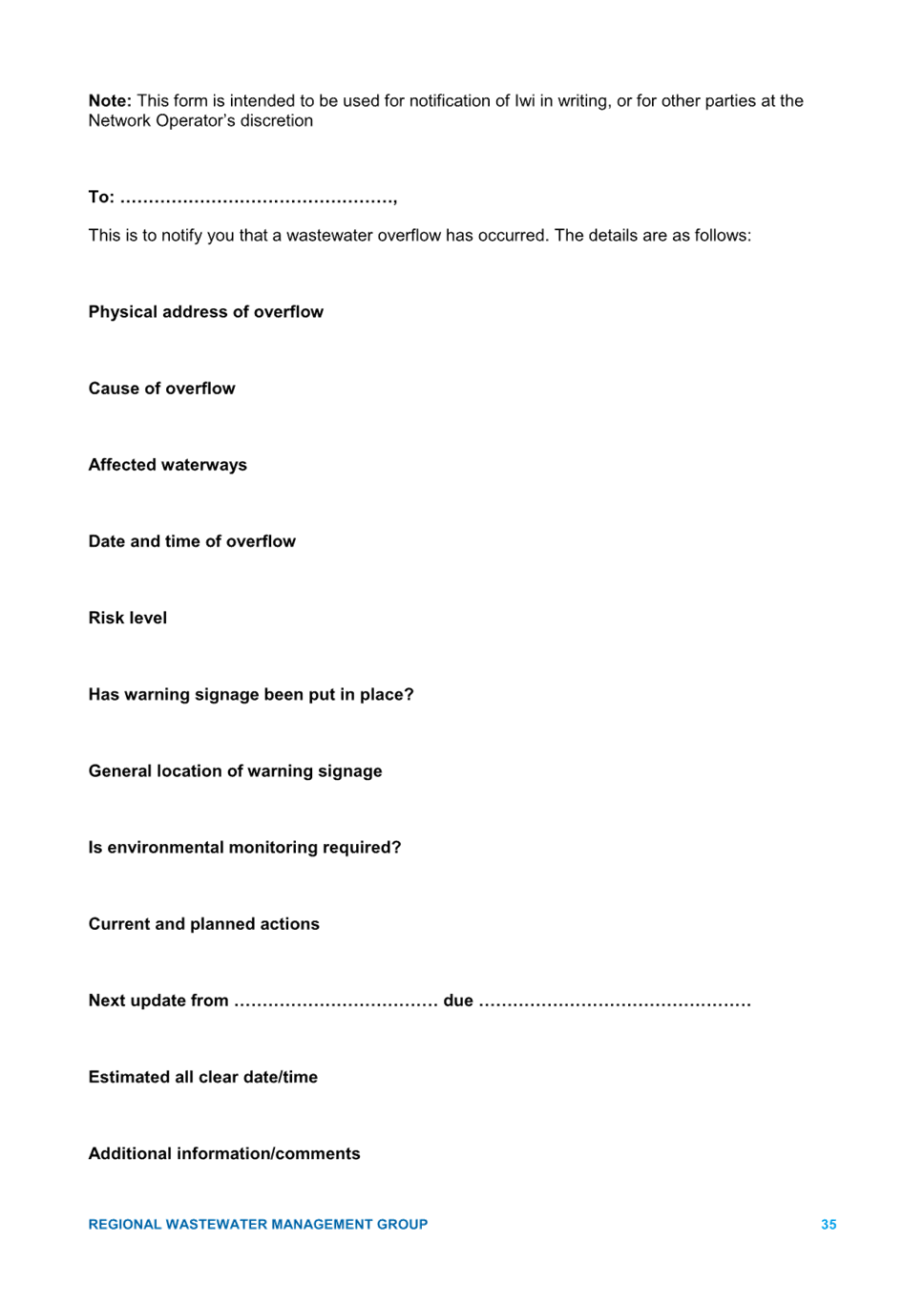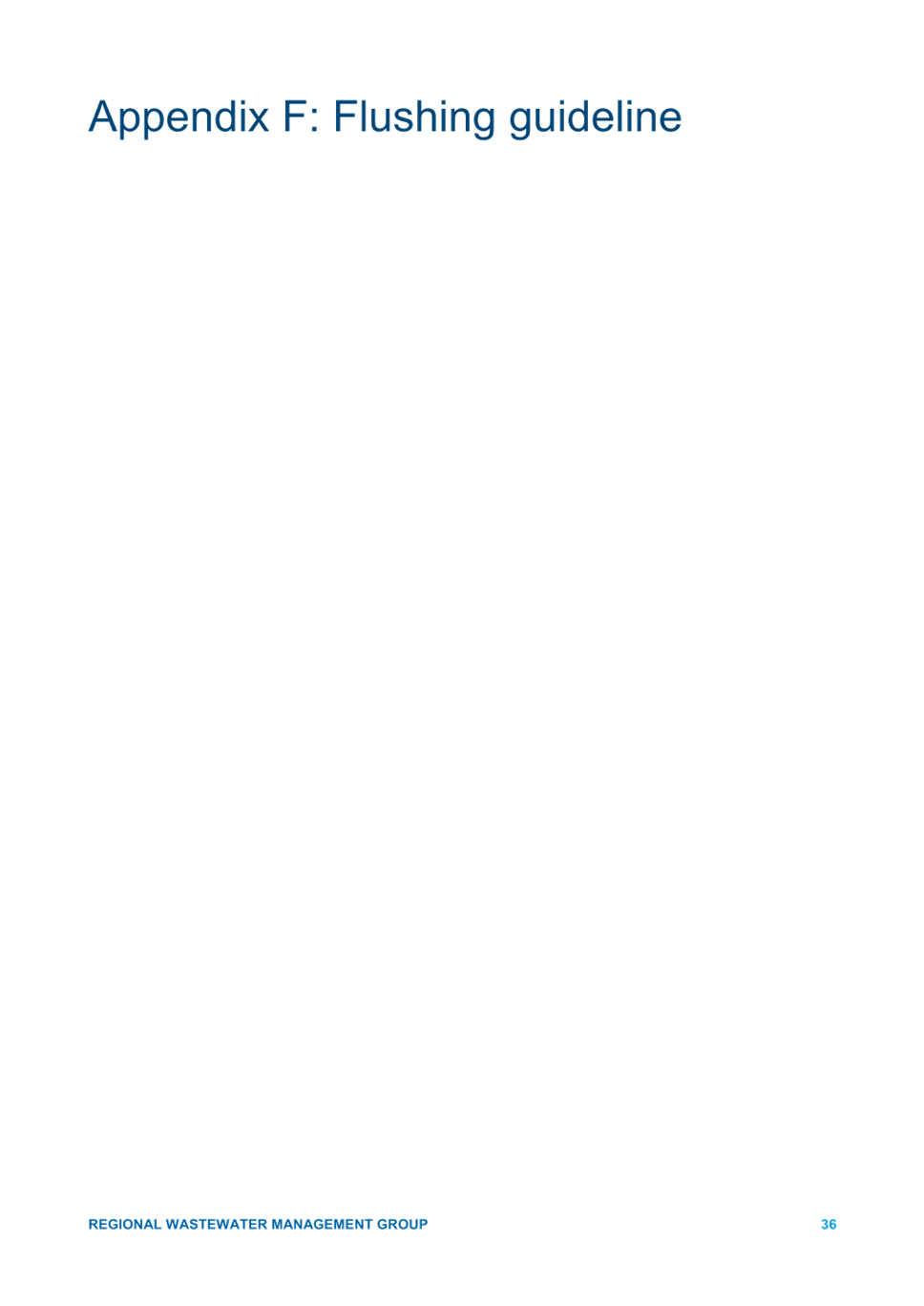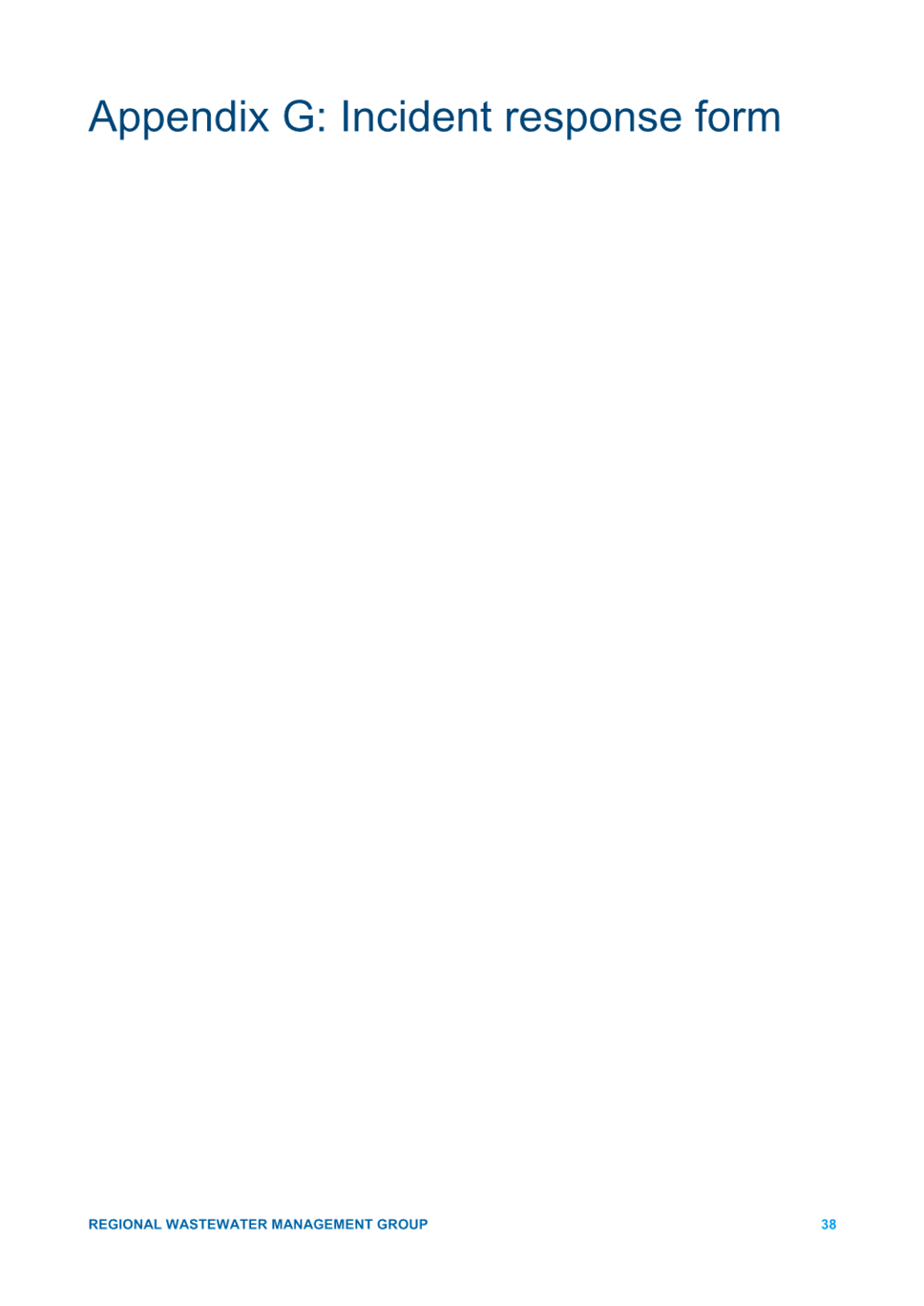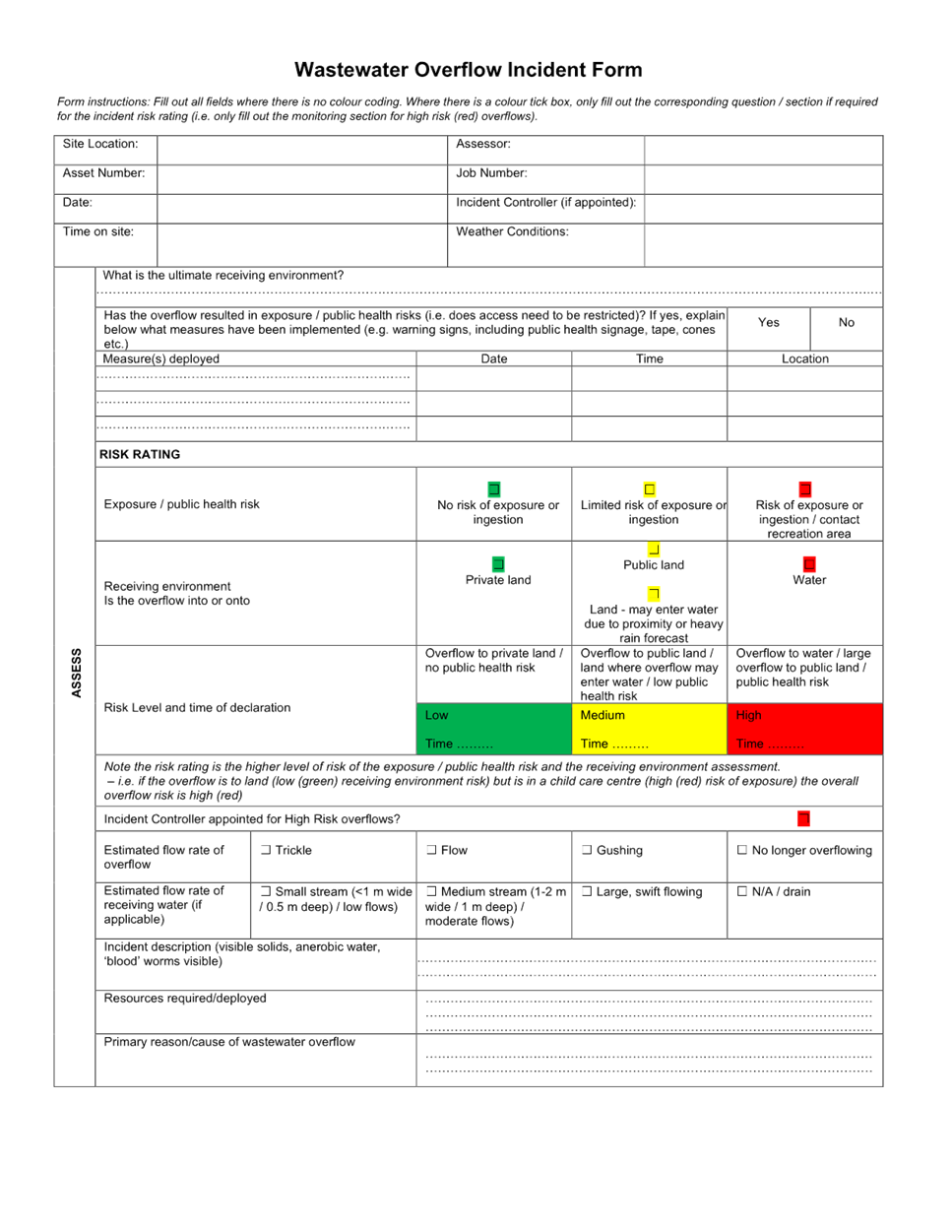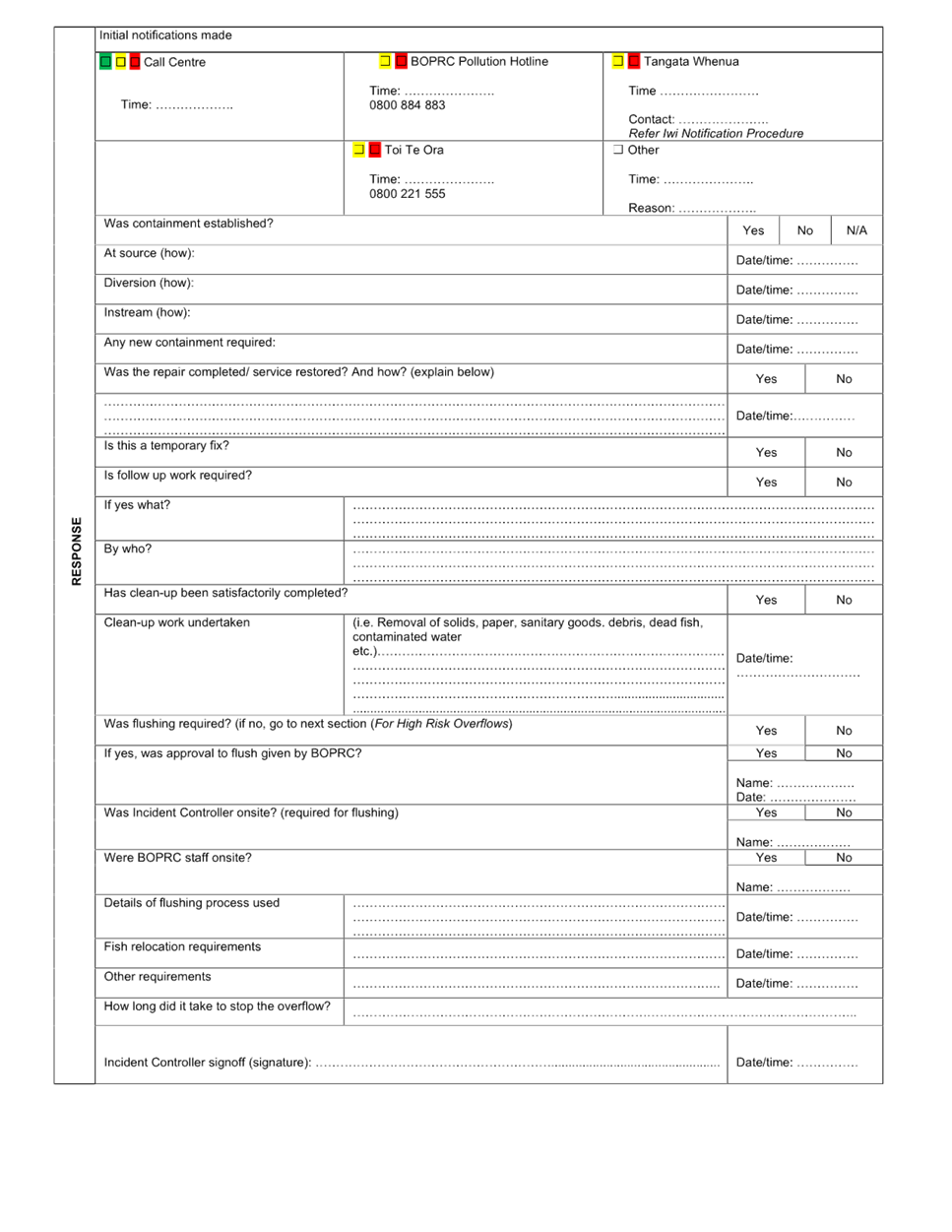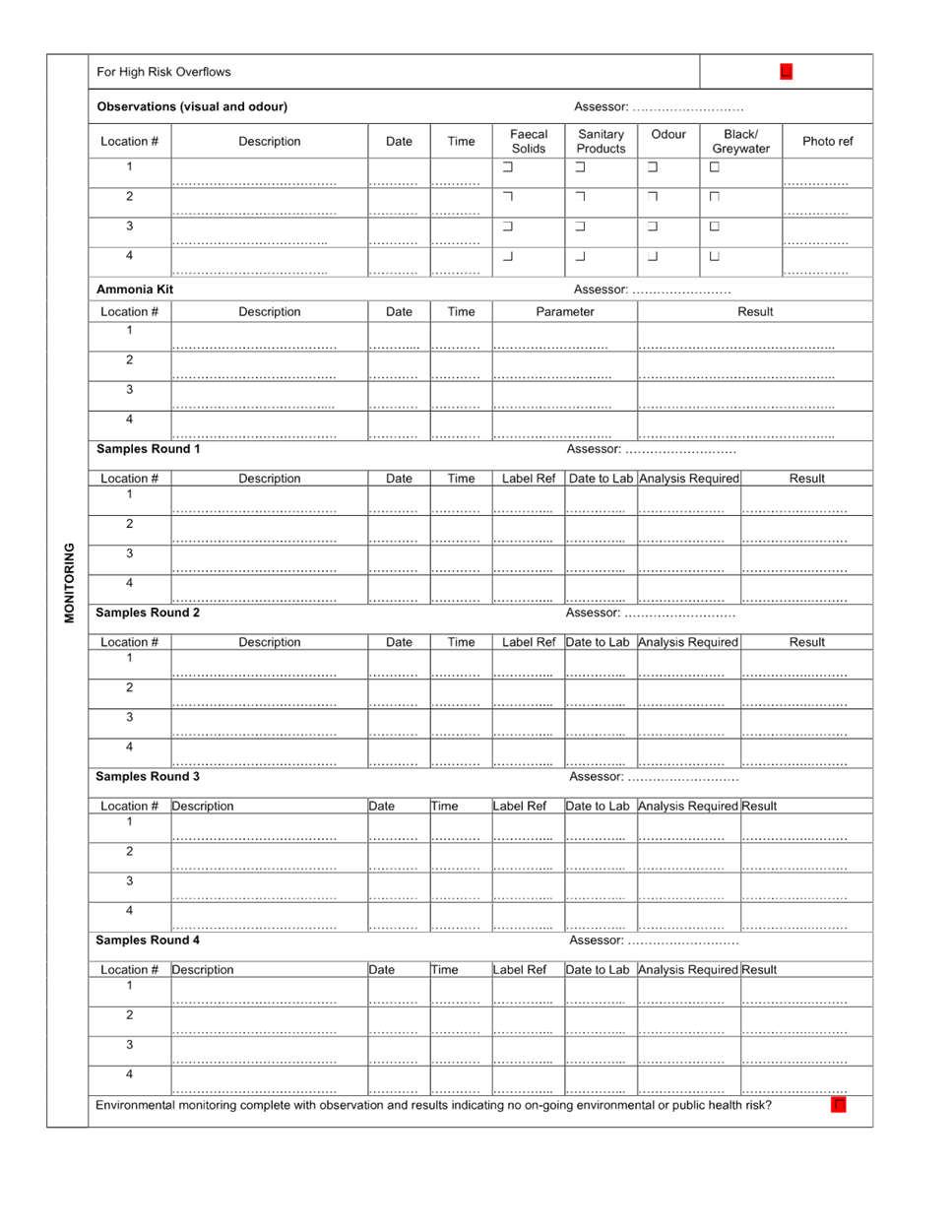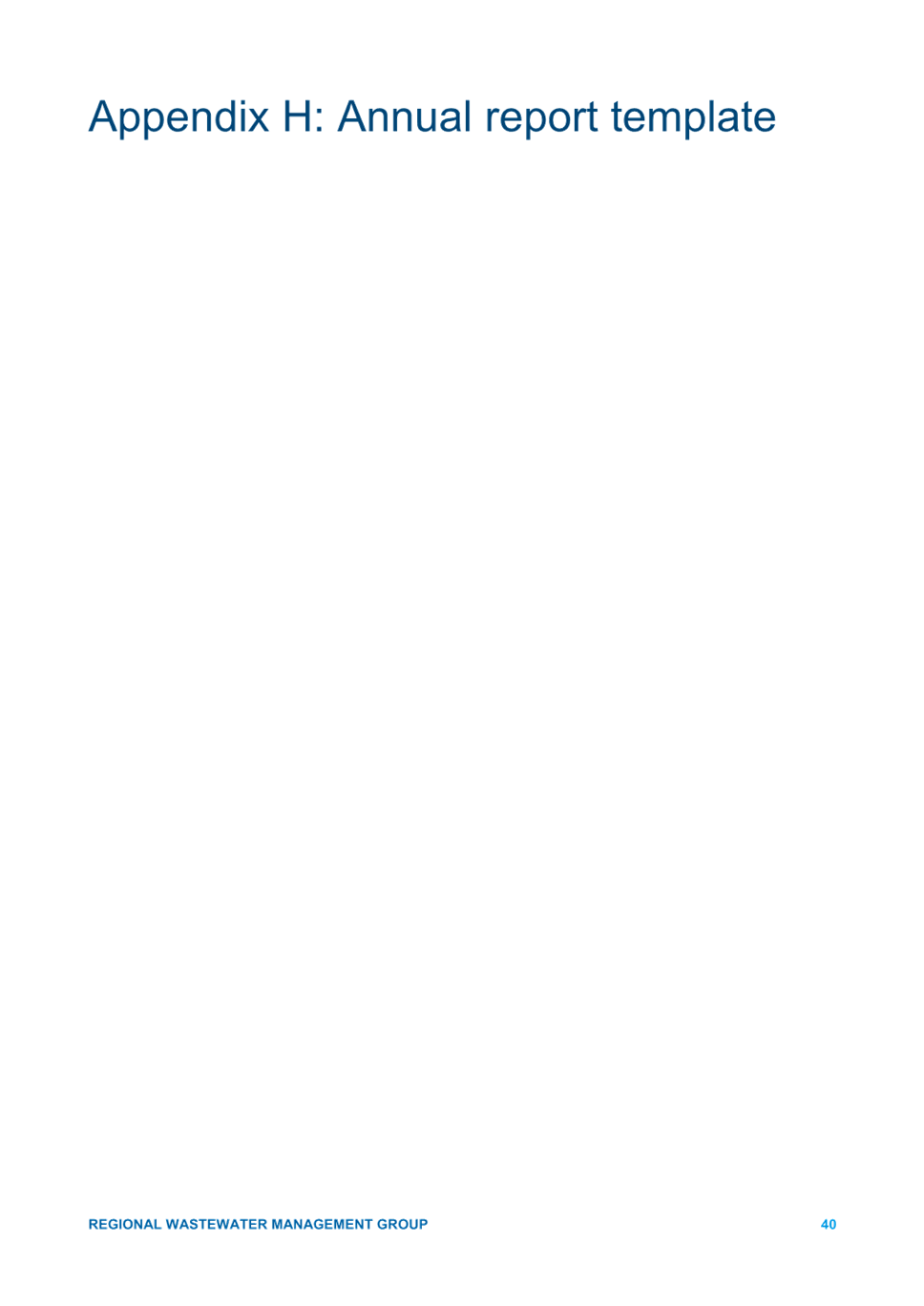|

|
|
AGENDA
Wastewater Management Review Committee Meeting
Wednesday, 31 August 2022
|
|
I hereby give notice that a Wastewater Management
Review Committee Meeting will be held on:
|
|
Date:
|
Wednesday, 31 August
2022
|
|
Time:
|
1pm
|
|
Location:
|
Ground Floor - Meeting Room 1
306 Cameron Road
Tauranga
|
|
Please note that this
meeting will be livestreamed and the recording will be publicly available on
Tauranga City Council's website: www.tauranga.govt.nz.
|
|
Marty Grenfell
Chief Executive
|
Terms of reference – Wastewater
Management Review Committee
Membership
|
Chairperson
|
To be appointed
|
|
Deputy chairperson
|
To be appointed
|
|
Members
|
Commissioner Stephen Selwood
– Tauranga City Council
Commissioner Bill Wasley –
Tauranga City Council
Commissioner
Shadrach Rolleston (alternate member – Tauranga City Council
Ms Lara Burkhardt – Ngā
Pōtiki
Ms Te
Rangimārie Williams – Ngā Pōtiki
Mr Whitiora McLeod - Ngāi
Te Rangi
Mr Des Heke - Ngāti
Ranginui
Ms Destiny Leaf (alternate
member – Ngāti Ranginui)
|
|
Quorum
|
Four
members with at least one member representing Tauranga City Council and one
member representing Ngā Pōtiki
|
|
Meeting frequency
|
A minimum of twice yearly
|
The Committee
previously has a membership of eight, four elected members from TCC and four
iwi. Currently the membership will be reduced to six, two Commissioners
appointed to represent the TCC and four who are appointed as representatives of
the Ngati Ranginui and Te Runanga o Ngai Te Rangi Iwi Trust and two members as
representatives of the Nga Potiki Kaitiaki Resource Management Unit.
The quorum has been
reduced from 5 to 4.
The Wastewater Management
Review Committee is established as a committee of Council by the Mayor under
section 41A of the Local Government Act 2002 and conditions imposed on Bay of
Plenty Regional Council Coastal Permit # 62878.
Role
· To ensure Wastewater operations are in accordance with the
Wastewater Management Review Committee Management Plan.
Scope
(a)
To receive reports on the operation of the Wastewater Scheme, including
reports in relation to monitoring and permit compliance, and to make
recommendations to the Permit Holder on the development of Tauranga City
Council's policies in relation to wastewater management, treatment and
disposal, particularly following the review of wastewater treatment in light of
new technologies and standards addressed in the Monitoring, Upgrade and
Technology Review Report required by Condition 20 of Coastal Permit No 62878.
(b)
To make decisions about the application of the Environmental Mitigation
and Enhancement Fund established in accordance with Condition 19 of Coastal
Permit N0 62878.
(c)
To make recommendations to the Permit Holder as to physical measures and
initiatives to address or compensate for actual or potential effects of the Tauranga
City Wastewater Scheme (in the broadest environmental sense).
(d)
Without limiting the generality of function (c) above, to make
recommendations to the Permit Holder as to the implementation of the works to
be undertaken in accordance with Permit No 62881, namely:
(i)
Decommissioning of the Te Maunga Sludge Pond and the future use of the
pond.
(ii)
Conversion of the Te Maunga Oxidation Ponds to wetlands.
(e)
To make recommendations to the Permit Holder in relation to the
independent consultant to be appointed to undertake the Monitoring, Upgrade and
Technology Review Report required by Condition 20 of Coastal Permit No 62878.
(f)
To make recommendations to the Permit Holder as to enhancing the
involvement of tangata whenua in sampling, testing and monitoring.
(g)
Assessment of the scope and adequacy of sampling and monitoring.
(h)
Notification to appropriate parties of activities that may have adverse
effects.
(i)
To receive, review and recommend action following receipt of wastewater
reports.
(j)
To recommend the commissioning of reports and future Tauranga City
Council actions on wastewater management, treatment and disposal issues and
options, including:
(i)
Development of alternatives to waterborne wastewater systems;
(ii)
Options for further treatments;
(iii)
Options for methods of disposal;
(iv)
Monitoring effects on the environment.
(k)
To co-ordinate and oversee education of the community on wastewater
management, treatment and disposal issues.
(l)
To identify and make recommendations to the Permit Holder as to sources
of funding which may be available to supplement the Environmental Mitigation
and Enhancement Fund established pursuant to Condition 19 of Coastal Permit No 62878
hereof and to be applied for the purposes specified in that condition.
(m) To
make recommendations to the Permit Holder as to changes to conditions of these
permits pursuant to section 127 of the Resource Management Act 1991, in light of the exercise of the Review Committee's
functions, including reports received and information received as a result of
monitoring, etc. or to avoid, remedy or mitigate actual or potential adverse
effects associated with the operation of the Wastewater Scheme.
(n)
To foster robust relationships and dialogue between the Review
Committee, the Permit Holder, the Western Bay of Plenty District Council and
Bay of Plenty Regional Council in relation to wastewater management, treatment
and disposal, particularly following the review of wastewater treatment in
light of new technologies.
(o)
To make recommendations to Bay of Plenty Regional Council as to
amendments to the conditions of these permits which could be implemented via a
review under section 128 of the Act in accordance with Condition 22 of Coastal
Permit N0 62878.
(p)
Prior to making any:
(i) Decisions
as to the allocation of the Environmental Mitigation and Enhancement Fund in
accordance with Condition 18.3(b) of Coastal Permit No 62878 hereof
or,
(ii) Recommendations
to the Permit Holder in relation to physical environmental mitigation or
enhancement or mitigation works in accordance with Condition 18.3(c) of Coastal
Permit No 62878 hereof; -
the
Review Committee will exercise its best endeavours to ascertain the existence
of any persons or bodies who may have a particular interest or stake in the
ecological health of the Tauranga Harbour (particularly the Upper
Harbour/Rangataua Bay area) and to consult with those bodies or persons as to
appropriate initiatives and measures to be so recommended (in accordance with
Condition 18.3(b)of Coastal Permit N0 62878) or undertaken (in
accordance with Condition 18.3(c)of Coastal Permit No 62878). As a
minimum, the Review Committee shall consult with
· Nga
Potiki Kaitiaki Resource Management Unit hapu and iwi of Te Runanga o
Ngaiterangi Iwi Trust, Ngati Ranginui and Ngati Pukenga and Te Arawa and their
respective hapu which hold kaitiaki status over the wider Tauranga Moana
district, including any Working Group established by those hapu or iwi;
·
Bay of Plenty Regional Council and the Western Bay of Plenty
District Council in relation to issues which may affect those councils in
accordance with their function under Condition 18.3(m) of Coastal Permit No
62878 hereof.
(q)
Not later than one month following the first anniversary of the
commencement of these permits and on each anniversary thereafter, the
Wastewater Management Review Committee shall forward to the General Manager,
Bay of Plenty Regional Council, a report on the exercise of its activities and
functions, including where appropriate a report on the effectiveness of
measures undertaken pursuant to the Environmental Mitigation and Enhancement
Fund.
(r)
Not less than six months following the first anniversary of this permit
and each fifth anniversary thereafter, the Wastewater Management Review
Committee’s annual report shall contain a review of its activities over
the previous five-year period and recommendations for appropriate initiatives
over the next five-year period, including any recommendations for changes to
conditions of these permits which may be considered necessary or desirable.
This report shall be available at least three months prior to the date on which
Bay of Plenty Regional Council is entitled to review the conditions of these
permits in accordance with Condition 22 of Coastal Permit No 62878
hereof.
(s)
A copy of this report shall also be provided to the Chief Executive,
Tauranga City Council.
(t)
As set out in Condition 18.1.3 of Coastal Permit No 62878,
the Wastewater Management Review Committee Management Plan may be amended with
the written approval of the Chief Executive of Bay of Plenty Regional Council
or delegate.
(u)
Confirmation of Committee minutes.
Reports to Council
and the Chief Executive of the Bay of Plenty Regional Council.
7 Confirmation
of minutes
7.1 Minutes
of the Wastewater Management Review Committee meeting held on 1 June 2022
File
Number: A13870212
Author: Anahera
Dinsdale, Governance Advisor
Authoriser: Anahera
Dinsdale, Governance Advisor
|
Recommendations
That the Minutes of the Wastewater Management Review
Committee meeting held on 1 June 2022 be confirmed as a true and correct
record.
|
Attachments
1. Minutes
of the Wastewater Management Review Committee meeting held on 1 June 2022
|
 Wastewater Management Review Committee Meeting Minutes Wastewater Management Review Committee Meeting Minutes
|
1 June 2022
|
|

|
|
MINUTES
Wastewater Management Review Committee
Meeting
Wednesday, 1 June 2022
|
Order of Business
1 Opening Karakia. 3
2 Apologies. 3
3 Public forum.. 3
4 Acceptance of late items. 3
5 Confidential business to be transferred into the open. 3
6 Change to order of business. 3
7 Confirmation of Minutes. 4
7.1 Minutes of the Wastewater Management Review Committee meeting held
on 10 November 2021. 4
8 Declaration of conflicts of interest 4
9 Business. 4
9.1 June 2022 Wastewater Activities Report 4
9.2 Programme Business Case Tangata Whenua Engagement and Communications
Plan. 5
9.3 Governance options for Wastewater Management Review Committee. 6
9.4 June 2022 Pond 1 Desludging Report 7
9.5 Environmental Mitigation & Enhancement Fund. 8
10 Discussion of late items. 9
11 Closing Karakia. 9
MINUTES
OF Tauranga City Council
Wastewater Management Review
Committee Meeting
HELD AT THE Ground Floor -
Meeting Room 1, 306 Cameron Road, Tauranga
ON Wednesday, 1 June 2022 AT
1pm
PRESENT: Commissioner Stephen Selwood, Commissioner Bill Wasley, Ms Lara
Burkhardt, Mr Des Heke, Ms Destiny Leaf, Mr Whitiora McLeod.
IN ATTENDANCE: Nic
Johansson (General Manager: Infrastructure), Radleigh Cairns (Acting Manager:
Drainage Services), Carlo Ellis (Manager: Strategic Māori Engagement),
Kelvin Hill (Manager: Water Infrastructure Outcomes), Claudia Hellberg (Team
Leader: City Waters Planning), Coral Hair (Manager: Democracy Services), Robyn
Garrett (Team Leader: Committee Support), Sarah Drummond (Committee Advisor)
1 Opening
Karakia
Mr Des
Heke opened the meeting with a karakia.
Acting
Chairperson Commissioner Bill Wasley welcomed Ms Destiny Leaf and noted that Mr
Des Heke was also in attendance.
2 Apologies
|
Apology
|
|
Committee Resolution WW2/22/1
Moved: Commissioner Bill Wasley
Seconded: Commissioner
Stephen Selwood
That the apology for absence received
from Ms Te Rangimarie Williams be accepted.
Carried
|
2 Public
forum
Nil
3 Acceptance
of late items
Nil
4 Confidential
business to be transferred into the open
Nil
5 Change to
order of business
At the
direction of the Chairperson, the meeting agreed to defer consideration of the
Governance Options report until later in the meeting, due to staff
availability.
6 Confirmation
of Minutes
7 Declaration
of conflicts of interest
Nil
8 Business
|
9.1 June
2022 Wastewater Activities Report
|
|
Staff Radleigh
Cairns, Acting Manager: Drainage Services
Key points
·
Summarised the key updates for the Programme
Business Case and the next steps planned.
·
The extra ground improvement works required
for the bioreactor project meant the project was running slightly behind
time. The outfall project was progressing well and was aligning closure, new
outfall and pond capacity. Still some resource consent work to do. Was
expecting connection of new outfall to existing pipeline in July.
·
Regarding the exceedances in March/April, it
was noted that a number of exceedances were allowed in the resource consent,
but these incidents were under investigation anyway. A reason could be extra
filter maintenance required but outfall was within resource consent
parameters. Uncertain at this stage exactly why these exceedances had
happened. Possibly to do with connection of the landward outfall.
In response
to questions
·
Tauranga City Council had investigated the
cause and taken actions for exceedance even though within resource consent
conditions and was still uncertain about reason for exceedances.
·
Recognised that whatever needed doing must
happen and could not be delayed. Had taken account of works in the Long-term
Plan and the updated Annual Plan. At some point closer to 2024 would
need to have a conversation about wider wastewater management issues for the
city given the expected growth.
Discussion
points raised
·
Programme Business Case workshops had allowed
for in-depth discussion and were progressing well. Also noted there was a
considerable time commitment for all involved in the Programme Business Case
workshops, and the workshops had built a mutual understanding of Te Tiriti o
Waitangi principles with good connections made.
·
Bioreactor to landfall section projects did
not have a Ngā Pōtiki cultural monitor in place until
a few months prior to Wastewater Management Review Committee Inaugural
meeting.
|
|
Committee Resolution WW2/22/3
Moved: Commissioner Stephen
Selwood
Seconded: Ms
Lara Burkhardt
That
the Wastewater Management Review Committee:
(a) Receives
the report: June 2022 Wastewater Activities Report.
Carried
|
|
9.2 Programme
Business Case Tangata Whenua Engagement and Communications Plan
|
|
Staff Radleigh
Cairns, Acting Manager: Drainage Services
Key points
·
Draft needed to be revised to reflect the
current Programme Business Case.
In response
to questions
·
The implementation of the engagement plan and
various milestones could come through to the Programme Business Case
workshops. The project team would need to review the engagement outcomes and
assessment per the criteria briefing developed in the Programme Business Case
workshops. Could also look at other reporting options to Te Rangapū Mana Whenua o Tauranga Moana.
·
Once Programme Business Case workshops were
completed, could have the engagement workshops happen in parallel with the
project team. Plan could be received by Tangata Whenua/Tauranga City
Council committee or Council as the Programme Business Case would affect the
wider city.
·
The overall Programme Business Case would be
in parallel with the Programme Business Case workshops so that the feedback from
the engagement can be incorporated. Staff wanted to be in the best
position for options by 2024. Ideally would have the shortest list possible
by that time.
·
Should strive to do the right thing to achieve
the right outcomes between Tangata Whenua and Council regardless of any
particular source of funding. Noted the need to align outcomes and
break down silos between projects and strategies.
Discussion
points raised
·
The Engagement and Communications plan sat
outside as a draft document and was a key important document. It needed to be
developed and progressed before it could be finalised. This was a parallel
process with the interests of this committee and other iwi/hapū that
were affected by the expansion of the city.
·
Draft needed to build on principles of
engagement. The draft would get the discussion going to get buy-in for the
Programme Business Case. It also needed to be considered wider as the
Programme Business Case impacted the whole city.
·
Māori land and infrastructure was an
ongoing concern and needed to fit in with infrastructure planning, urban
growth and resilience.
·
Expressed the need for a voice for Māori
landowners and iwi/hapū. Might not be a programme that came out of
this business case but would be an ongoing issue for Tauranga City Council to
address.
·
Expressed the need to link high level planning
e.g. the 15th Ave/Turret Rd strategy and to consider Māori
land in all the projects, look at equity of services to Māori land
compared to non-Māori land.
·
Needed to find a way to support tangata whenua
to provide quality input into meetings. Discussion around doing an engagement
plan for a particular purpose or project, but an alternative could be to have
a series of continual wananga for tangata whenua representatives to provide
co-ordination across projects, strategies and higher level issues such as
growth, infrastructure and impacts on Māori land.
·
Engagement plan could be used as a model for
ongoing engagement. Possibility this could link in with Three Waters in terms
of funding.
|
|
Committee Resolution WW2/22/4
Moved: Commissioner Stephen
Selwood
Seconded: Mr
Whitiora McLeod
Moved: Commissioner Stephen
Selwood
Seconded: Mr
Whitiora McLeod
That
the Wastewater Management Review Committee:
(a) Receives the Report and previous draft engagement plan.
(b) Recommends to
staff to continue with a review of the plan including:
(i) Undertake
the required workshops to create the plan.
(ii) Undertake
the required engagement to carry out the plan.
Carried
|
|
9.3 Governance
options for Wastewater Management Review Committee
Staff Coral
Hair, Manager: Democracy Services
Key points
·
The Local Government Act 2002 (LGA) did not
provide for official co-chairs; however, if a Chair and Deputy Chair were
appointed, they could act as co-chairs by alternating meetings. Both would be
involved in agenda briefings.
·
Summarised the process for appointing a Chair
and Deputy Chair.
·
Developed position descriptions for iwi
representatives. When completed they would be benchmarked by an outside
agency to determine appropriate remuneration and should be reviewed
regularly. The suggested review was three-yearly in conjunction with election
cycle.
In response
to questions
·
Strategic pay review also included the
alternate roles.
·
Similar process undertaken for the Tangata
Whenua representatives to the Strategy, Finance and Risk Committee.
·
Suggestion of the Chair being a Tangata Whenua
representative. If Council had not appointed a Chairperson than the Committee
could do so, and it was up to the Committee to decide its process.
·
Commission as a whole exercised the power of
the Mayor rather than an individual commissioner. While the appointment
of the Wastewater Management Review Committee Chair had usually sat with the
Mayor; the Committee could decide to make its own appointment.
·
An appointment panel was being used for the
appointment of the independent chairperson for the Tangata Whenua/Tauranga
City Council Committee, which would then provide a recommendation of
appointment to Council. This was not an option for the Wastewater Management
Review Committee under the Terms of Reference.
·
Quorum was four which was decided by Council.
Five was considered a risk as only six committee members in total. For a
meeting to proceed, there must be one Ngā Pōtiki
member and one Tauranga City Council member present. Previously had
been four councillors and four Tangata Whenua representatives.
Discussion
points raised
·
If there was a desire to move from the status
quo of a Council appointed Chair and Committee appointed Deputy Chair, it was
suggested to leave those decisions to lie on the table while any alternate
processes were discussed by both commissioners and tangata whenua
representatives.
·
Majority of Terms of Reference were taken from
the resource consent so limited flexibility to change. Needed to align the
management plan that sits underneath the resource consent with any Terms of
Reference changes and update Bay of Plenty Regional Council.
·
Noted the Terms of Reference provided for
appointment of alternates.
Committee
Resolution WW2/22/5
Moved: Commissioner Stephen
Selwood
Seconded: Mr
Whitiora McLeod
That
the Wastewater Management Review Committee:
(a) Receives
the report “Governance Options for Wastewater Management Review
Committee”.
(e) Recommends
to Council that the position description for the Chairperson and Deputy
Chairperson as set out in Attachment 2 are adopted.
(f) Recommends
that alternate representatives for iwi representatives be appointed to ensure
a quorum can be met.
Carried
|
|
Committee Resolution WW2/22/6
Moved: Commissioner Stephen
Selwood
Seconded: Mr
Whitiora McLeod
That the Wastewater Management Review
Committee agrees to leave recommendations (b), (c) and (d) of the Governance options for Wastewater Management Review
Committee report to lie on the table until the next meeting.
Carried
|
|
9.4 June
2022 Pond 1 Desludging Report
|
|
Staff Radleigh
Cairns, Acting Manager: Drainage Services
Key points
·
Decision was taken prior to Council approving
funding to be brought forward in the Long-term Plan to get desludging started
in order to meet requirements to decommission.
·
Contract had been let and work would start
July 2022.
·
Estimates of the amount of sludge varied and
there was a lot of windblown sand also in the pond. Staff would not know the
exact amount until the project started. The timeframe around disposal to the
landfill could be tight so looked at ways to extend that if needed.
Looked at options such as double shifts to try and meet timeframes set in the
resource consent.
In response
to questions
·
Transporting sludge off-site added
considerably to the cost of the project. There were no local sites that could
take this type of sludge product; sites most likely to be utilised were
Hampton Downs or the vermiculture plant. All options would be explored.
The more local a disposal site was, the cheaper in terms of cost.
Discussion
points raised
·
Tangata whenua would like Tauranga City
Council to investigate quickly another disposal site if one would be needed
to meet timeframes. Acknowledged that this may cost more money but expressed
concern and did not want any more going to that site. Needed to get on
with remediation of the site as soon as possible.
·
Ngā Pōtiki
concerned with disposal not a closed landfill and endorsed other options
being investigated.
|
|
Committee Resolution WW2/22/7
Moved: Commissioner Stephen
Selwood
Seconded: Ms
Lara Burkhardt
That
the Wastewater Management Review Committee:
(a) Receives the report, June 2022 Pond 1 Desludging Report.
Carried
|
|
9.5 Environmental
Mitigation & Enhancement Fund
|
|
Staff Radleigh
Cairns, Acting Manager: Drainage Services
Key points
·
Reviewed criteria and guidelines for
application to the fund. The recommendation was to appoint a panel to
consider applications. This report set out a process to establish the
appointment panel.
·
Reissue request for expressions of interest
for the assessment panel. There were not many applications received the first
time.
·
Mr McLeod was happy to be appointed to the
appointment panel. Also a nomination was received for Te Rangimarie Williams.
In response
to questions
·
The Terms of Reference for the assessment
panel were discussed. These needed to be updated to reflect commissioners not
elected members, and to update dates. Consequential amendments were needed
from today’s meeting decisions.
Discussion
points raised
·
Commission representatives suggested that the
appointment panel representatives could both be tangata whenua appointees
rather than including a commissioner.
·
The rationale for Point 5 of project
eligibility criteria – the fund only covering 50% of the project cost
– was discussed. This requirement had been added by the tangata whenua
members, and was around a project being more viable/achieving good outcomes
if there was alternative funding available as well as TCC funding. Was
about providing confidence that the project had been pre-worked and
well-scoped, and applicants were committed to completion of the
project. 50% requirement could be revisited, may not be achievable for
some parties interested in applying for funding. Suggested that the
need for confidence in applicants’ commitment could be addressed by a
different way e.g. asking for demonstrated effort to find additional
funding/alternative funding. Assessment panel provides recommendations
to the Committee, there was a discretion with the Committee in terms of
amount of funding to be granted.
·
Two applicants were successful in 2013. The
projects were monitoring Rangataua Bay, and fed into wider work that was
being done rather than council projects as such. That was not solely council
information, would need to make sure there were no restrictions on where that
information could be provided; should be able to be provided to the committee
members. Be useful for continuity with the Fund and meeting Fund
objectives.
·
Possible changes to the Manual to make sure it
was clear that research such as projects to look at alternative options to
ocean outfall were covered by the Fund. This could fall under the existing
criteria, nothing that would work against an application for that kind of
project.
·
Mātauranga Māori should be included
as one of the areas of expertise listed under clause 5.
|
|
Committee Resolution WW2/22/8
Moved: Ms Lara Burkhardt
Seconded: Commissioner
Stephen Selwood
Abstained: Mr
Whitiora McLeod
That
the Wastewater Management Review Committee:
(a) Receives
the report, Environmental
Mitigation & Enhancement Fund .
(b) Reviews
the EMEF policy manual and approve any changes as required.
(c) Approves
the appointment process for appointing members of the EMEF independent panel.
(i) Appoints
Whiti Macleod as representative on the appointment panel.
(ii) Appoints
Te Rangimarie Williams as representative on the appointment panel.
(d) Reviews
and approves the terms of reference for the members of the EMEF independent
panel.
Carried
|
9 Discussion
of late items
Nil
10 Closing
Karakia
Mr Des
Heke closed the meeting with a karakia.
The
meeting closed at 3.03pm.
The
minutes of this meeting were confirmed as a true and correct record at the
Wastewater Management Review Committee meeting held on 31 August 2022.
...................................................
CHAIRPERSON
9 Business
9.1 Governance
options for Wastewater Management Review Committee
File
Number: A13655270
Author: Coral
Hair, Manager: Democracy Services
Authoriser: Christine
Jones, General Manager: Strategy, Growth & Governance
Purpose of the Report
1. This
report sets out governance options for the Wastewater Management Review
Committee to consider.
|
Recommendations
That the Wastewater Management
Review Committee:
(a) Receives
the report “Governance Options for Wastewater Management Review
Committee”.
(b) Recommends
to Council that (insert name) is appointed as the Chairperson of the Wastewater
Management Review Committee.
(c) Appoints
(insert name) as the Deputy Chairperson of the Wastewater Management Review
Committee.
(d) Recommends
to Council that the Chairperson and Deputy Chairperson of the Wastewater
Management Review Committee alternate presiding of meetings and that the
amended terms of reference for the Wastewater Management Review Committee as
set out in Attachment 1 are adopted.
|
Executive Summary
2. Following feedback
from the tangata whenua members of the Wastewater Management Review Committee
(WWMRC), staff were requested to look at enabling the WWMRC to have
Co-Chairpersons (Co-Chairs).
3. Co-chairs are not legally
able to be appointed to council committees. However, the Chairperson and Deputy
Chairperson of the WWMRC could agree to alternate to preside over meetings,
thus effectively acting as co-chairs. This arrangement can be set down in
the Terms of Reference of the WWMRC.
4. Vacancies exist for
the Chairperson and the Deputy Chairperson position. This provides an
opportunity to discuss how these positions are filled.
5. The WWMRC
considered a report on this matter at its meeting on 1 June 2022 and left the
decision on appointments to lie on the table until this meeting.
6. Remuneration
for tangata whenua representatives on the WWMRC has been evaluated by an
external expert. A report on this, and other remuneration, will be
going to the Council for a decision on 5 September 2022.
Background
7. The
WWMRC at its meeting on 1 June 2022 considered a report on Governance options
for the WWMRC and resolved the following:
“That the Wastewater
Management Review Committee:
(a) Receives
the report “Governance Options for Wastewater Management Review Committee”.
(e) Recommends
to Council that the position description for the Chairperson and Deputy
Chairperson as set out in Attachment 2 are adopted.
(f) Recommends
that alternate representatives for iwi representatives be appointed to ensure a
quorum can be met.”
8. The
WWMRC did not resolve recommendations (b), (c) and (d) and these were left to
lie on the table until this meeting to enable both the Commissioners and
tangata whenua representatives consider their desire to move away from the
status quo. These recommendations are presented again for the WWMRC to
consider.
Discussion
and options
9. The provisions of
the Local Government Act 2002 relating to the appointment of a chairperson of a
committee refer to the appointment of a person, singular, as the chairperson,
which does not allow for the appointment of a co-chair. As such, the
positions of Chairperson and Deputy Chairperson are appointed and remain
separate.
10. However, the Chairperson can
vacate the chair for all or part of a meeting and enable the Deputy Chairperson
to chair the meeting.
The Chairperson is able to be present and participate in the meeting, including
voting, while not chairing the meeting.
This would enable the two roles to effectively act as co-chairs.
11. This pre-supposes that the
Chairperson agrees to vacate the chair to enable the Deputy Chairperson to
chair the meeting at pre-agreed times.
The Terms of Reference would need to state that it is the intention that this
occurs, however, there is no ability to enforce this practice if the
Chairperson decides not to vacate the chair for a particular meeting.
12. Only one person can chair a
meeting at any one time. The person chairing the meeting has the powers
of the chairperson as set out in standing orders. They would also have the
option to use the casting vote (under Standing Order 19.3) in the case of an
equality of votes. It is recommended that this be explicitly stated in the
terms of reference for clarification.
13. The Chairperson and Deputy
Chairperson would attend pre-agenda briefings (usual practice) and split any
other duties outside of meetings, e.g. spokesperson for WWMRC. The
position description for these roles was approved at the last meeting and will
go to the Council for adoption at the Council meeting on 5 September 2022,
along with any recommendations from this meeting. The position
description is included again for members’ information in Attachment 2.
14. Options for appointing the
Chairperson and Deputy Chairperson are set out below:
|
Option
|
Details
|
Comments
|
|
1
|
Chairperson is
appointed by the Council following a recommendation by the WWMRC and filled
by a Commissioner/Tangata Whenua representative
|
Recommended
option.
A recommendation
from WWMRC would require endorsement from the Council.
With the
co-chair arrangement, the position would work closely with the Deputy
Chairperson.
|
|
2
|
Chairperson is
appointed by the WWMRC and filled by a Commissioner/Tangata Whenua
representative
|
Appointment
would come from WWMRC.
Refer to the
Strategic/Statutory section for comments around appointments by committees.
|
|
3
|
Deputy
Chairperson is appointed by the Council and filled by a Commissioner/Tangata
Whenua representative
|
A recommendation
from WWMRC would require endorsement from the Council.
With co-chair
arrangement, the position would work closely with the Chairperson.
|
|
4
|
Deputy
Chairperson is appointed by the WWMRC and filled by a Commissioner/Tangata
Whenua representative
|
Recommended
option.
Appointment
would come from WWMRC. Reflects previous practice for appointments of Deputy
Chair for WWMRC.
|
15. It is recommended that at
least one Commissioner and one Tangata Whenua representative is appointed as
either the chairperson or deputy chairperson, as set out in the draft Terms of
Reference in Attachment 1.
16. In the absence of a
Chairperson or Deputy Chairperson, the WWMRC can elect one member to chair each
meeting.
17. Another option for discussion
is that a person could be appointed as the Chairperson for a stated period of
time, with another person appointed as the Chairperson for a further
period. For example, a Commissioner or elected member appointed for one
year, and a Tangata Whenua Representative appointed for the following year.
Strategic
/ Statutory Context
18. The
WWMRC is a special committee established both by the Council (under the Local
Government Act 2002) and the management plan approved by the Bay of Plenty
Regional Council that sets out how the WWMRC is to operate under the conditions
of resource consent 62878 and the iwi membership of this is set by the
consent. The management plan is silent on the arrangements for
chairing the meetings. This is not a matter that would be addressed under this
plan and there is no requirement to amend this plan to spell out chairing
arrangements. The Local Government Act 2002 requirements relating to
chairing of meetings, and the appointments of a Chair and Deputy Chair apply.
19. The Mayor has the power under
section 41A (3)(c) to appoint the chairperson of each committee and Council has
the power to discharge a chairperson appointed by the Mayor (section 41A(4)
(d)). The Commission Chair does not have the powers of the Mayor and
therefore Clauses 25
and 26(3) of Schedule 7 of the Local Government Act 2002 (LGA) apply.
Sub-clauses 26(3) and (4) state:
(3)
The local authority may appoint a member of a
committee to be the chairperson of that committee and, if the local authority,
on the appointment of the committee, does not appoint a chairperson, that power
may be exercised by the committee.
(4)
The local authority or the committee may
appoint a deputy chairperson to act in the absence of the chairperson.
remuneration
for tangata whenua representatives
20. Independent
advisors Strategic Pay were asked to review the remuneration of the Tangata
Whenua members on the WWMRC following the appointment of new committee members.
21. A
report on this, and other remuneration, will be considered by Council for a
decision on 5 September 2022.
22. Currently remuneration for iwi
representatives on the WWMRC is based on the Tangata
Whenua Remuneration Policy.
23. It is recommended that
remuneration be reviewed regularly following each election.
Financial
Considerations
24. Any
financial impacts from an increase in remuneration would be meet through
current budgets.
Legal
Implications / Risks
25. The
WWMRC can continue to meet without appointing a chairperson or deputy
chairperson but this is not recommended. Appointing a chair and deputy
chair enables the committee to meet its stated purpose.
Significance
26. The
Local Government Act 2002 requires an assessment of the significance of
matters, issues, proposals and decisions in this report against Council’s
Significance and Engagement Policy. Council acknowledges that in some
instances a matter, issue, proposal or decision may have a high degree of importance
to individuals, groups, or agencies affected by the report.
27. In
making this assessment, consideration has been given to the likely impact, and
likely consequences for:
(a) the current
and future social, economic, environmental, or cultural well-being of the
district or region
(b) any persons who are likely to be
particularly affected by, or interested in, the .
(c) the capacity of the local authority to
perform its role, and the financial and other costs of doing so.
28. In
accordance with the considerations above, criteria and thresholds in the
policy, it is considered that the issue is of low significance.
ENGAGEMENT
29. Taking
into consideration the above assessment, that the issue is of low significance,
officers are of the opinion that no further engagement is required prior to
making a decision.
Next
Steps
30. The Council approves the
WWMRC’s recommendation and appoints the Chairperson of WWMRC.
31. The terms of reference of the
WWMRC are adopted by Council on 5 September 2022.
32. The remuneration for tangata
whenua representatives on the WWMRC is considered by Council on 5 September
2022
Attachments
1. Draft
Terms of Reference for the Wastewater Management Review Committee - A12794638 ⇩ 
2. Position
Description for Chairperson and Deputy Chairperson of the Wastewater Management
Review Committee - A12794637 ⇩ 
3. Position
Description for Tangata Whenua Representatives on the Wastewater Management
Review Committee - A13655428 ⇩ 
|
Wastewater Management Review
Committee Meeting Agenda
|
31 August 2022
|




|
Wastewater Management Review Committee
Meeting Agenda
|
31 August 2022
|



|
Wastewater Management Review Committee
Meeting Agenda
|
31 August 2022
|


9.2 Wastewater
Overflow Management Report
File
Number: A13761189
Author: Radleigh
Cairns, Manager: Drainage Services
Authoriser: Nic
Johansson, General Manager: Infrastructure
Purpose of the Report
1. To
provide information to the Wastewater Management Review Committee on the issue
of dry and wet weather wastewater overflows, the current response, reporting
and notification requirements and the ongoing work undertaken by staff to
reduce the incidence of these events within the city.
|
Recommendations
That the Wastewater
Management Review Committee:
(a) Receives
the report “Wastewater Overflow Management Report”
|
EXECutive
Summary
2. Members of the committee
have previously requested that staff provide information on wastewater
overflows within Tauranga, Council’s response to overflows and any work
undertaken to prevent overflows to the receiving environment.
3. Overflows can be
split into two categories being: Wet weather overflows caused by inflow and
infiltration of stormwater and groundwater into the wastewater network; and Dry
weather overflows caused by blockages and damage to the network during normal
flows.
4. Staff have reviewed
wastewater requests data for the last three financial years and found that
between the financial years 2019 to 2022 (July 2019 to June 2022) a total of
almost 550 network incidents have been reported within the wastewater network
over this period.
5. These events can be
categorised as follows:
· 85%
were dealt with either before any discharge from the network eventuated or were
contained to land (either private or public).
· 7%
resulted in a discharge to the stormwater network where it was contained and
did not reach a receiving environment.
· 8%
resulted in discharges that potentially reached a receiving environment
(waterway / harbour / ocean) and required notification.
6. TCC has agreed with
Bay of Plenty Regional Council (BoPRC) to follow the Regional Best Practice
Guide for the Management of Overflows (Attachment 1) when responding,
reporting and notifying wastewater overflows from the wastewater network.
7. Council
acknowledges its responsibility to continually work towards minimising the
incidence of wastewater overflows from its wastewater network and has a variety
of programmes that contribute to that aim including: operational maintenance;
capacity modelling and planned upgrades; as well as educational programmes
raising awareness within the community.
DISCUSSION
Overflows and Response
8. Flows into the
wastewater network come from three main sources. Dry weather flow (a
combination of domestic and non-residential loads), groundwater infiltration
(water entering the network from the groundwater table) and rainfall derived
inflow and infiltration (RDII - rainfall which enters the network from a
variety of pathways).
9. The wastewater
network is designed and constructed to convey dry weather flows (based on
population density and water consumption rates) with an additional infiltration
factor to size the pipes for dealing with other flows (such as RDII).
10. Wet weather overflows can
occur when the capacity of the network in certain areas is exceeded due to
inflow and infiltration during a rain event. Dry weather overflows tend to
occur when a blockage constrains flow in the network, or the network is damaged
or fails.
11. From July 2019 to June 2022
TCC notified 41 Overflows that reached or potentially reached a receiving
environment. Across the three years numbers were stable with 15 in 2019/20, 12
in 2020/21 and 14 in 2021/22. Only one of these overflows appeared to be due to
a wet weather capacity issue.
12. The response to any blockage
or overflow in the network follows the Best Practice Guide produced by the Bay
of Plenty Regional Wastewater Management Group (which includes The Bay of
Plenty Regional Council, Toi Te Ora and the six Territorial Authorities within
the region including TCC, Attachment 1).
13. The purpose of the technical
guide is to provide an agreed standardised framework and key performance
targets for the response, monitoring and reporting of wastewater overflows by
Network Operators and contracted service providers across the region.
14. Council via its maintenance
contractor are required to respond as soon as possible to any overflow/blockage
once alerted, with the contractor to be onsite within 60 minutes to assess the
situation. Initial focus is on containing and stopping any discharge from the
network and normally involves removing any blockage or repairing damage to the
network.
15. If the overflow cannot be
contained or has potentially already reached the stormwater network and a
receiving environment then the notification and reporting process is begun,
with BoPRC, Toi Te Ora and affected hāpu and iwi notified. If it is a
significant community area for recreation or access a wider media advisory may
also be undertaken.
16. Council will always err on the
side of caution and warn of potential impacts from wastewater overflows by
notifying and placing warning signage in affected areas prior to any water
quality testing providing conformation that there has been an impact on the
receiving environment.
17. Follow up will include any
longer-term repairs required or investigations into the reasons for the
overflow, water quality testing to assess whether there is any ongoing
environmental impact on the receiving environment as well as potentially
educational work on raising awareness of the cause within the catchment’s
residents and businesses.
18. Any incident requiring
notification under the guide requires a report to be provided to BoPRC on the
completion of any follow up work.
19. The guide does not cover
consented overflows from the treatment plants for example during extreme
weather events. However, these consents have their own notification and
reporting requirements that are similar. The last use of one of these consents
was in June 2018 when many areas of the city received 100-150mm of rain in one
day with areas receiving over 30mm/hr at times.
20. Council has a number of
programmes aimed at minimising and reducing the number of blockages and
overflows from the wastewater network that includes: operational maintenance;
capacity modelling and planned upgrades; as well as educational programmes
raising awareness within the community. These target both Wet weather and Dry
weather events.
Preventative
Maintenance
21. Council contractors undertake
scheduled maintenance on areas of the network where potential blockages have
been known to build up previously. These areas are “flushed” to
remove any blockages that may have begun to build up. These could be areas
where the network configuration makes it easy for build ups of fat to occur or
a slumped pipe waiting on a more permanent repair for example.
22. TCC undertakes CCTV of the
wastewater network to identify locations where renewals and or maintenance is
required. CCTV is resource intensive requiring the initial video work but also reviewing
the footage before any improvements can be made.
23. Council trialled a rapid
assessment tool (SL-RAT®) in 2021 that provided a highly portable rapid
onsite blockage assessment enabling any CCTV and cleaning resources to be more
effectively utilised.
24. The trial covered over 5km of
the network including 115 manholes in 4 days and identified 15 manholes that
needed repairs and 2 sites that required emergency flushing to clear blockages
and preventing potential overflows.
25. Council have agreed to
resource the use of the rapid assessment tool over the next three years and are
currently working through some technical reporting issues before the project
begins. Use of this type of technology could potentially enable TCC to assess
its full network (700+ kilometres) every 5 years.
26. Council monitors both flow and
levels within certain manholes and pump stations to provide data that can be
used in modelling and planning for upgrades.
Wastewater Education
27. The Waterline School programme
has been educating our tamariki on all things wastewater for over a decade and
Council have recently completed a review that incorporated a number of changes
requested by schools of the hugely popular programme. These included more
activity based learning and interactive segments that utilised their online
resources.
28. When blockages caused by wipes
or fats and grease occur, the catchment where the blockages originated is
identified and staff mail drop information on the blockage and the impacts
reminding residents not to flush these wastes into the system.
29. This builds on Council’s
“Save our Pipes from Wipes” campaign that was launched in late 2018
after Tauranga’s internationally recognised beach, Pilot Bay was
temporarily closed due to a wastewater overflow caused by wet wipes.
30. A noticeable reduction of the
number of blockages caused by wet wipes was achieved during the launch of this
campaign. Since then, numbers have been relatively constant.
31. A new Australian-New Zealand
Flushable Products Standard - DR AS/NZS 5328:2021 has been established to
identify products that are safe to flush down the toilet. This flushability
standard is the first of its kind in the world, and it has been a collaboration
between water utilities (including TCC) and manufacturers in its
development.
32. While the Standard is
voluntary, it provides manufacturers with clear pass/fail criteria for products
suitable for toilet flushing. Manufacturers are required to pass six testing
criteria and an attestation that there is no plastic in the product. They
are also expected to start using the flushable symbol in the coming months.

33. Flushable products will have a
clearly identifiable symbol on the packaging. If it does not have this symbol,
it does not meet the flushability standard and should be put in the bin, not
the toilet.
34. Staff plan to commence
engagement with supermarkets and retailers stocking wet wipes. This will
be to raise awareness of the new standard and to influence their decisions
around these products. The commerce commission will be responsible for
compliance to the standard.
35. The Waterline team are about
to launch a new early childhood programme focussed on wet wipes that will be
rolled out at kindergartens and other pre-schools with the objective of reducing
the amount of wet wipes that are flushed down the wastewater network.
36. TCC’s Trade Waste
Officers visit both Industrial and Commercial businesses within the city to
educate business owners on the impacts of wastes discharged to the network,
ensure the required treatment options such as grease traps are in place and
monitor discharges through the application of trade waste consents for high
risk activities.
Inflow and
Infiltration (I&I) Strategy
37. The level of groundwater
infiltration and rainfall derived inflow and infiltration (RDII) into the
network can vary based on the condition and/or set up of the system (e.g.,
cracked/broken pipes allowing infiltration, faulty manhole covers, connection
of roof drains into the system). The network’s response to rainfall
usually determines the frequency at which network capacity is exceeded, and
unplanned overflows due to capacity constraints may occur.
38. I&I can be difficult to
measure and requires extensive data collection and resources. It is specific to
a given catchment and can also change over time as asset condition
deteriorates. However, understanding levels of I&I enables Council to
assess system capacity, make sound investment decisions and effectively manage wet
weather wastewater flows for current and future populations.
39. Council has developed a
strategic wastewater network model (SWNM) to manage the network capacity. The
model identifies peak wet weather flows in the trunk network leading to the
wastewater treatment plants and can predict where, and when, this can result in
unplanned overflows from the system. The model also assesses the percentage of
I&I into the network.
40. The SWNM shows very low rates
of I&I in the Tauranga wastewater network. The modelled rates of I&I
are between 0.3% and 2.5% (from flow gauge calibration), with an average rate
of 1.2%. Other wastewater service providers in New Zealand have reported rates
of I&I between 5-10%. This means that Council’s main focus should be
maintaining low I&I rates.
41. Council has also commissioned
a draft I&I strategy. The I&I strategy will document current and future
work needed to manage I&I into all sections (public and private) of
Tauranga’s wastewater network where it may contribute to wet weather
overflows. As Tauranga’s I&I% is already low, the strategy will focus
on identifying issues and prioritising catchments where I&I remediation
work is likely to mitigate wet weather wastewater overflows in a cost-effective
manner.
Long Term Plan
Capital Works Programme & Network Model
42. For the 2021- 2031 LTP a
static hydraulic model for the network was developed to identify potential
capacity constraints in the network (i.e., where we could expect to see wet
weather overflows). The model used asset data, design flows and population
forecasts to identify areas and compared this against reported incidents to
find problem areas to be prioritised for options to be included in the LTP. A
number of these projects are currently underway.
43. For the 2024-2034 LTP the
model will be dynamic allowing a range of scenarios to be tested and will
consider the hydraulic constraints of the wastewater treatment plants in any
optioneering and prioritisation of improvement works.
Next
Steps
44. Further updates will be
provided as requested by the Wastewater Management Review Committee (WWMRC).
Attachments
1. BOPRC_Best
Practice Guide for Managing WW Overflows December 2019 (A11182777)_Optimized -
A13868621 ⇩ 
|
Wastewater Management Review
Committee Meeting Agenda
|
31 August 2022
|

























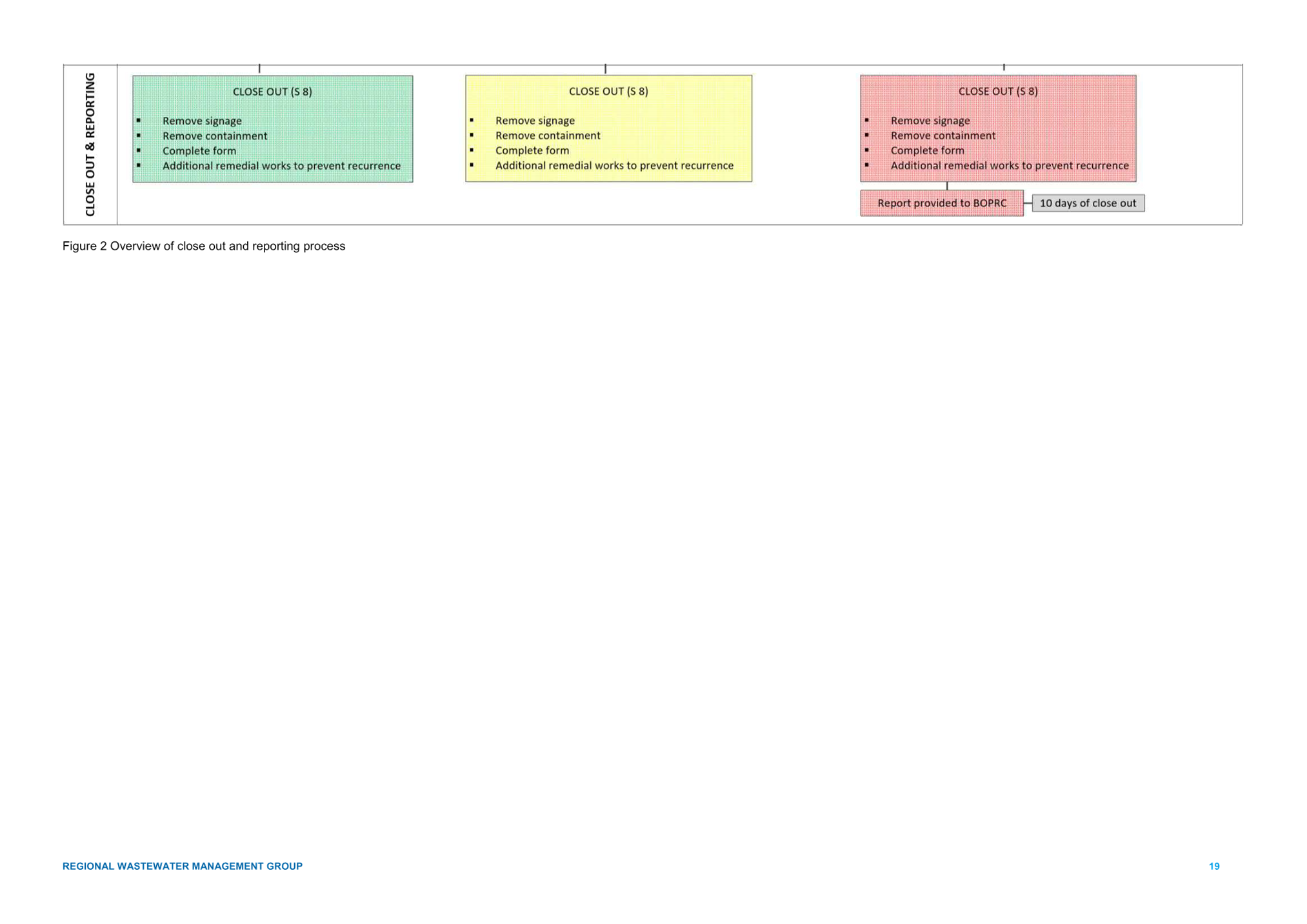


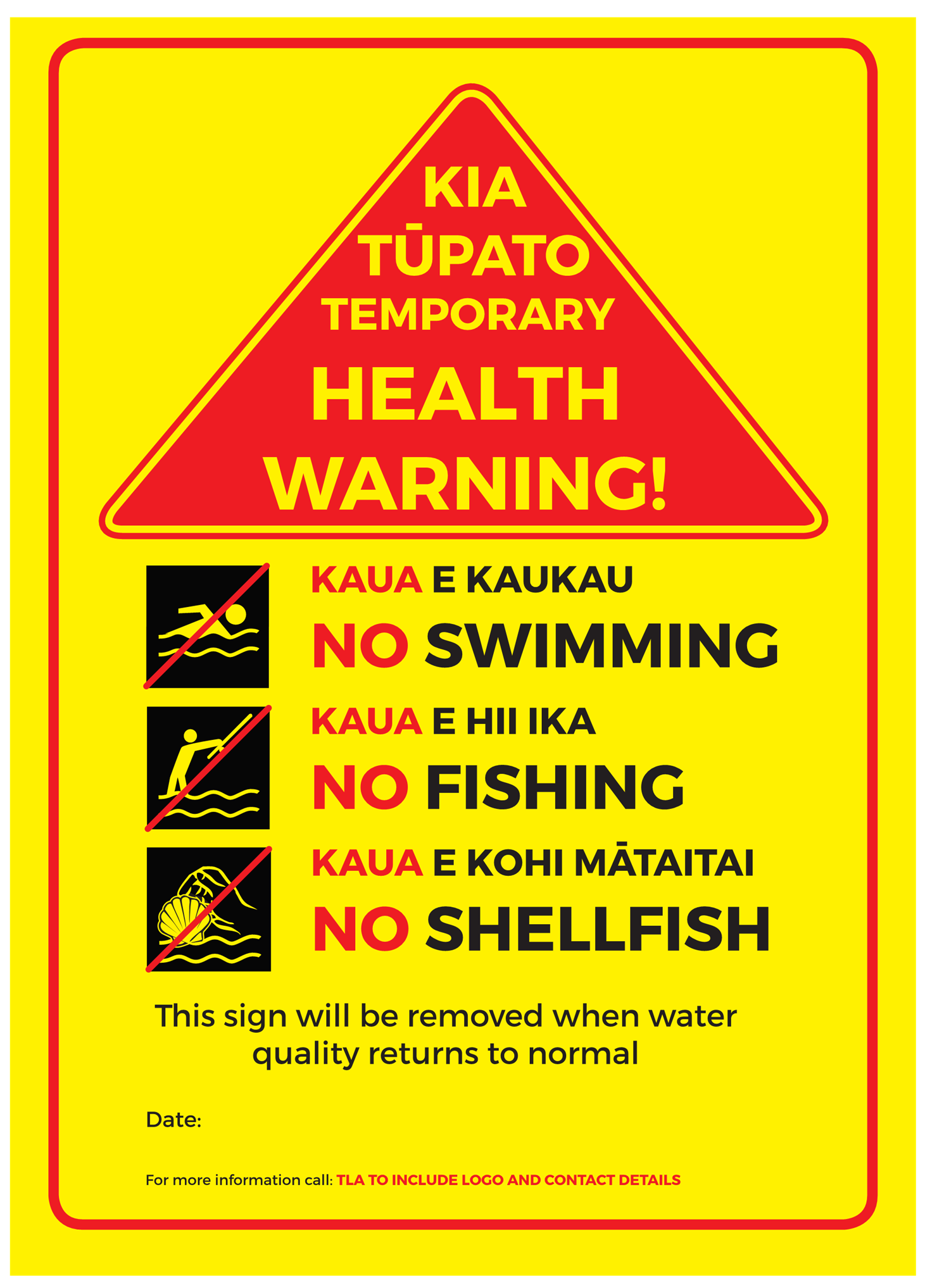
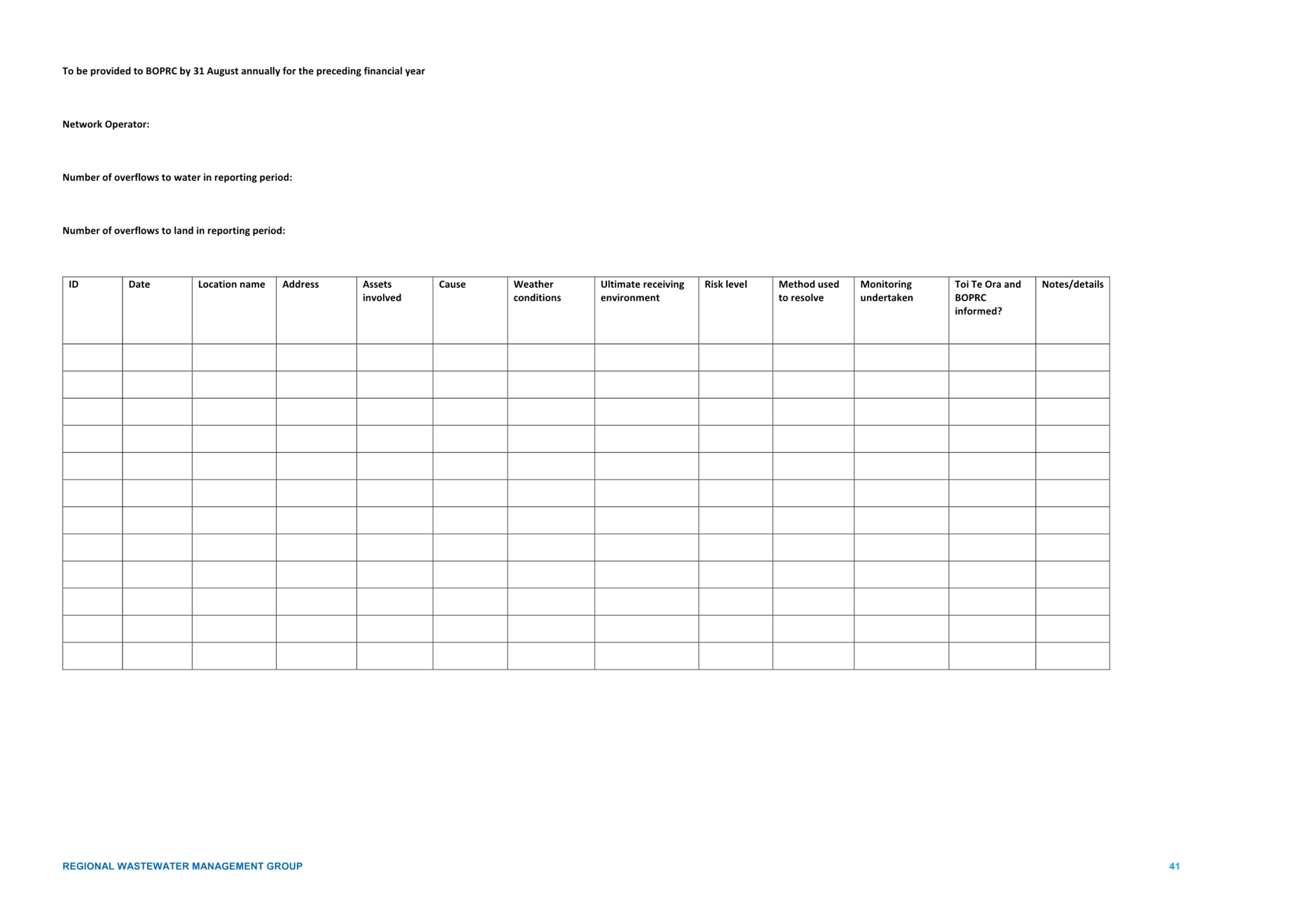
9.3 Wastewater
Activities Report August 2022
File
Number: A13849280
Author: Radleigh
Cairns, Manager: Drainage Services
Authoriser: Nic
Johansson, General Manager: Infrastructure
Purpose of the Report
1. The
wastewater activities report provides information on the current activities in
the wastewater area.
|
Recommendations
That the Wastewater
Management Review Committee:
(a) Receives
the report "Wastewater Activities Report August 2022".
|
Discussion
Wastewater Programme
Business Case
2. The Wastewater
Programme Business Case (PBC) has been initiated to define a ‘preferred
way forward’ for future investment for the marine outfall and the
wastewater scheme. TCC is currently working on integrating its network and
plant strategies to enable integrated investment and a PBC is an ideal vehicle
to address this. A project team has been established to work through the PBC
process consisting of technical and planning experts, staff and tangata whenua
representation from the Wastewater Management Review Committee. Collectively
they will work to identify key issues with the wastewater scheme, develop
objectives for future investment and propose possible options or responses
which could be implemented to address to these issues.
3. The team will assess
a long list of options against broad range of prescribed criteria, considering
environmental, cultural, and economic outcomes. Utilising a broad range
of criteria aligns well with the changes indicated through the Three Waters
Reforms where there will be an increased focus on improved environmental
outcomes (e.g., through a new NES for Wastewater Discharges and Overflows), and
greater consideration of cultural values when upgrading networks and
plants.
4. Following
assessment against the criteria, a short list of options will be the subject of
further analysis. These long and short lists are likely to include both
infrastructure and non-infrastructure responses.
5. The PBC defines a
‘preferred way forward’ for future investment across the wastewater
scheme as a whole and will guide strategic planning for Council’s
wastewater activity, inform future detailed business cases and key strategic
documents such as the Long-Term Plan and 30 Year Infrastructure Strategy.
It will also set the scene for wastewater when Tauranga City potentially moves
into a new water services entity.
6. Progress to date on
the PBC includes draft outputs from the project Team for the following:
o Investment
Logic Map: confirm problem statements and define benefits from investment
o Benefits,
KPIs and Measures: baseline and target values to be confirmed
o Investment
Objectives
o Investment
Scope: levels of scope the investment is required to deliver
o Key
Service Requirements: which key services and to what level (minimum, intermediate,
maximum) the programme investment is expected to deliver.
7. The next steps for
the PBC include:
· Recommence
formal PBC workshops with the Project Team to confirm:
· Refinements
made by Tangata Whenua representatives to outputs a.-e. (refer Attachment 1).
· Assessment
Criteria: against which long list programme options will be evaluated.
· Long
list of options: that can deliver the investment objectives
· Long
list assessment: of options against criteria
· A
short list of options: for further analysis.
8. This work will be
carried out over a series of formal PBC workshops to occur over the remainder
of 2022 and possibly into early 2023. Given the volume of material to be
covered, complexity and rate of progress, timing for workshops is uncertain as
is the date for ultimate completion of the PBC (where the ‘preferred
roadmap for investment’ will be confirmed).
9. Development of a
stakeholder engagement plan for both community and cultural
engagement/communications to support the PBC is required. This will
likely include workshops seeking input and feedback from the Te Rangapu and Iwi
and Hapu groups and presentations to the Te Awanui Tauranga Harbour Advisory
Group at a minimum. The engagement plan will identify other stakeholders
and also reflect the points in the PBC process at which this input and feedback
should be sought.
Te Maunga
Upgrades
Bioreactor Two
10. Two
contractors have established on site, one (Brian Perry Civil) is carrying out
the ground improvements, the other (HEB Construction) is commencing with the
manufacture of precast elements for the structure.
11. The
ground improvement work trials are still ongoing while TCC and the contractor
resolve pile quality issues. A further site trial has commenced and if
successful it is anticipated that ground improvements will be complete by the
end of March 2023.
12. HEB
Construction, who are constructing the above ground works, expect to have
completed the manufacture of all of the precast elements by November 2022 and
will have to wait until the ground improvement work is completed before
commencing with the erection of the structure.
13. The
scheduled date for completion of Bioreactor 2 is December 2023 however this
will be reviewed once the ground improvement issues are resolved.
Landward Outfall
14. This
project is proceeding well with all of the 1200mm diameter pipeline now laid in
the ground. Hydrostatic testing of the pipeline is underway and the pipeline
will become operational at the beginning of October 2022.
15. Council
is still assessing options for lining the remaining 450m of existing landward
outfall. Staff recently received a Cultural Impact Assessment from Nga Potiki a
Tamapahore Trust for one of the proposed options and this is currently being
reviewed. The lining itself does not require consent as it is allowed for in
the current discharge consent and so the preference is to progress options that
do not require any further consenting and are less intrusive on the surrounding
area.
Clarifier Three
16. Piling
trials are due to begin and the preliminary design phase is on track for
completion at the end of September 2022.
17. The
construction of the foundation system and floor slab has been brought forward
and will commence in April 2023. The above ground works will be carried out
thereafter. The overall result will be that Clarifier 3 could be completed 8
months ahead of programme.
Desludging Pond 1
18. The contractor has established
on site and is finalising their equipment set up. Desludging will commence in
September and continue for approximately 18 months dependent on the amount of
sludge within the pond. Council will increase the monitoring of seepages from
quarterly to monthly while desludging is underway and work with the contractor
to manage flows during the works.
Opal Drive Pumpstation Upgrade
19. Opal
Drive Pump Station is a key pump station as it pumps the majority of wastewater
flows from the eastern and central Papamoa area and Wairakei Urban Growth Area
(UGA) through to the Te Maunga wastewater treatment plant (TMWWTP), future
flows from the Te Tumu UGA will also pass-through Opal pump station.
20. The
current pump station occupies 1980m² at the northern end of 45 Opal Dr,
the total site area is 8390m². 45 Opal Dr is a designated site (C81) for
the purpose of a “wastewater pumping station” in the Tauranga City
Plan. Kainga Ora’s transitional houses have recently been removed
from Site B to enable the ground investigations and subsequent construction of
a new Opal Dr pump station. The Kainga Ora housing will remain on Site A for at
least another 5 years (Figure 1)
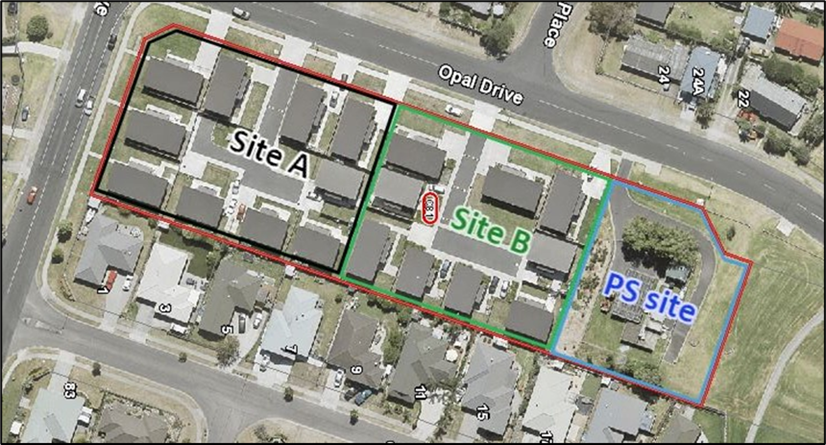
Figure
1: Opal Drive Pump Station (PS Site). Also include 45 Opal Dr:
Designation boundary in red with the current pump station site outlined in
blue, transitional housing sites A&B outlined in black and green
respectively.
21. The
preliminary design of the pump station has been completed which provides an
understanding of the site layout and above ground structures to be constructed
as part of the project. It is Council’s intent to design these structures
to fit in with the residential setting of the area.
22. As
part of the construction of the new pump station the existing incoming and
outgoing wastewater pipelines will need to be realigned. The eastern corridor
wastewater strategy also anticipates two additional wastewater pipelines: from
the future Wairakei pump station to Opal pump station and from Opal pump
station to Te Maunga Wastewater Treatment Plant. They are expected to be
constructed in the current road corridors between the Wairakei Stream and the
coast.
23. The
comprehensive stormwater consent (RC63636) provides for the duplication of all
the storm water culverts on the Wairakei stream. We expect to deliver
these culvert upgrade works on Opal Dr at the same time as the wastewater works
to avoid disrupting the community twice in this area and for efficiency in
undertaking the work.
24. We
are in the process of engaging with mana whenua in relation to this project, as
part of this we are seeking advice on whether it is appropriate to include
cultural elements in the aesthetic design of the pump station structures and/or
landscaping. If so, then we would want to work with mana whenua to
include those cultural elements.
Consent Monitoring
25. All results from receiving
environment sampling are within consented limits. There has been an increase in
seepage rates due to higher levels in Pond 1 resulting from the increase in
rainfall over the winter months.
26. No odour complaints regarding
the treatment plants have been received. The bi-annual odour survey is due to
take place in the last quarter of 2022.
Environmental
Mitigation & Enhancement Fund
27. The Wastewater Management
Review Committee appointed two representatives to the appointment panel in June
2022. Staff are working with these committee members to advertise an expression
of interest for the independent panel that will review any applications to the
fund. Council expects the panel to be in place before the end of 2022 for
applications to open in early 2023.
Next
Steps
28. Further updates will be
provided at the next Wastewater Management Review Committee (WWMRC) Meeting.
Attachments
Nil







































